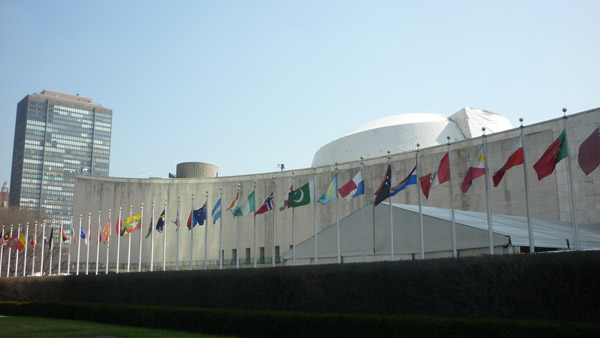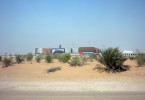
This week a small but poised Ecocity Builders delegation including Kirstin Miller, Naomi Grunditz and myself got to spend time at UN Headquarters in New York to witness the first round of ‘Informal-Informal’ negotiations on the Zero Draft of the Outcome Document of the UN Conference on Sustainable Development, or Rio+20.
As the issue of sustainable development, or how all humans can prosper without destroying the planet we live and depend on, is global, far-reaching and multidimensional in nature, these negotiations do not only involve governments and diplomats…

Delegates during the negotiations, Photo Earth Negotiation Bulletin
but active participation of all sectors of society and all types of people – consumers, workers, business persons, farmers, students, teachers, researchers, activists, indigenous communities, and other communities of interest, also known as major groups.

Farmers representative in the plenary, photo Earth Negotiation Bulletin
As such, we were invited to join the discussion on how to solve these complex problems, not only with a keen eye toward the role cities will play in the final outcome document, but also to network and exchange ideas with other stakeholders on how to ultimately translate all the talk into specific action on the ground.
We were pretty excited to see the paragraph ascribed to cities in the zero draft of the document, which is the agreed upon starting point of the negotiations:
We commit to promote an integrated and holistic approach to planning and building sustainable cities through support to local authorities, efficient transportation and communication networks, greener buildings and an efficient human settlements and service delivery system, improved air and water quality, reduced waste, improved disaster preparedness and response and increased climate resilience.
Of course, by the time the UNCSD delegates had gone through their first reading of Section V (Framework for Action and Follow-up), a whole new picture appeared. Here just a small sample from the third day of informal consultations, as excerpted from the Earth Negotiations Bulletin:
On cities, CANADA supported the US proposal on sustainable transportation. NEW ZEALAND recommended maintaining resilient ecosystem services. The REPUBLIC OF KOREA introduced its proposal on including greener buildings in city planning. The EU reserved on Japan’s proposal to establish a platform to promote sustainable cities. Proposals for a new title included “Human Settlement, Sustainable Cities, Rural Development and Housing” (G-77/CHINA) and “Cities and metropolitan regions and opposed to extend it to rural development” (EU). The US suggested replacing “low carbon cities” with “sustainable cities” or “low emission cities.” The G-77/CHINA identified slum prevention and upgrading as key elements.

Delegates consulting on the text, photo Earth Negotiation Bulletin
It’s a little bit like a global sausage-making town hall, and actually quite amazing how courteous, efficient and fast-moving this process is, considering that it literally involves the entire world.
While the process is quite fascinating and I enjoyed my time sitting in the plenary, the real action for us happened in our major group meetings, side events, and casual meetings in the UN cafeteria, aka the Viennese Cafe. It’s in those meetings where NGOs and civic groups can get a chance to talk to some of the delegates and give their input on what should be included in the draft.

John Matuszak, US, meets with NGOs, photo Earth Negotiation Bulletin
There’s obviously no guarantee that any of it will be included, or if it does, it may very well get deleted again at a later point in the negotiations, but just this morning at our daily major groups briefing, Nikhil Seth, Director for Sustainable Development at the UN, reiterated that civil participation is strongly encouraged and asked us to not get frustrated by the sometimes very arduous process. He likened it to a wave that kind of sucks you in and spits you back out, but ultimately will move us all forward.

There’s definitely a palpable excitement about this new commitment by the UN to include stakeholders from all walks of life and society. While most of the input may not make it into the final document, there’s no doubt that people at the highest levels are willing to listen to a broad range of ideas and let their thinking be inspired by the experiences and lessons from the ground.
For example, for us it was pretty cool to be invited, along with a group of other interested NGOs, to Swedish ambassador Staffan Tillander’s office, to discuss a possible ‘friends of the city’ network that could pool our knowledge and broaden our scope to make the voice of sustainable cities stronger.
Naomi, who is fluent in Swedish, had a chance for a photo-op with the ambassador.

This is really just the beginning of a non-stop process that will go on throughout the coming weeks, into June, and really, beyond the conference. Whatever language ends up in the final document, the real challenge will be to translate the words, intentions and treaties into action. I’ll be writing more in the coming weeks about some really exciting projects Ecocity Builders is working on for Rio and beyond, but for now, as I’m heading out of the laboratory of UN Headquarters into the field of the New York Highline, I’ll leave you with a photo of Kirstin and me, with hopeful hearts for big deeds.









For the hope factor alone, this appears to have been well worth the purchase of a tie. Congrats on your invitation. And thank you.
not to forget the fun factor, Ruth. 😉 Thanks for stopping by!
[…] the last few months I’ve been peripherally involved in the sometimes hopeful, sometimes frustrating, but always interesting process of midwifing the […]
[…] the last few months I’ve been peripherally involved in the sometimes hopeful, sometimes frustrating, but always interesting process of midwifing the […]
[…] intrigued by urban planning. Soul paths turned into bike paths. Birth charts slowly gave way to Zero Drafts. As Buddhist teacher and author Jack Kornfield so aptly puts the quest for enlightenment: […]